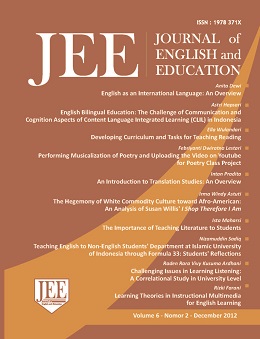Main Article Content
Abstract
Learning theory is the concept of human learning. This concept is one of the important components in instructional for learning, especially English learning. English subject becomes one of important subjects for students but learning English needs specific strategy since it is not our vernacular. Considering human learning process in English learning is expected to increase students' motivation to understand English better. Nowadays, the application of learning theories in English learning has appeared in several learning methods and media. One of popular media today is instructional multimedia by using computer. There are many educators who design English material in certain computer software or games. It is still possible to apply learning theories in instructional multimedia program since multimedia provides complete learning by using text, picture, sound, video and animation. Multimedia program can adapt students' differences in learning. It is a good potential of collaborating learning process and technology to learn English better. The program will help students to master the whole English language competence (listening, speaking, reading and writing). This paper will discuss the types of learning theory that can be used in instructional multimedia to learn English. This paper also provides several examples of instructional multimedia product that contain learning theories application.
Key Words: Learning theories, Instructional multimedia, English learningArticle Details
Copyright (c) 2016 Journal of English and Education

This work is licensed under a Creative Commons Attribution-ShareAlike 4.0 International License.
Authors who publish with this journal agree to the following terms:
- Authors retain copyright and grant the journal right of first publication with the work simultaneously licensed under a Creative Commons Attribution-ShareAlike 4.0 International License that allows others to share the work with an acknowledgment of the work's authorship and initial publication in this journal.
- Authors are able to enter into separate, additional contractual arrangements for the non-exclusive distribution of the journal's published version of the work (e.g., post it to an institutional repository or publish it in a book), with an acknowledgment of its initial publication in this journal.
- Authors are permitted and encouraged to post their work online (e.g., in institutional repositories or on their website) prior to and during the submission process, as it can lead to productive exchanges, as well as earlier and greater citation of published work (See The Effect of Open Access).

